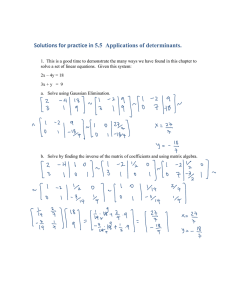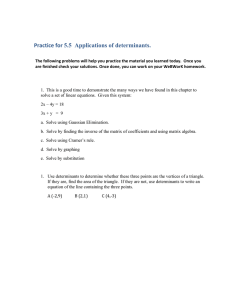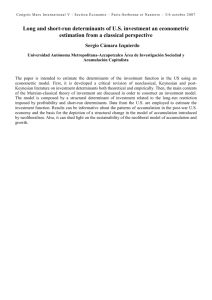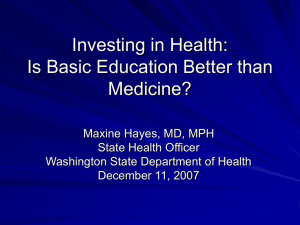Social Determinants of Health: 10 Major Points Presentation for Academy Health Meeting
advertisement
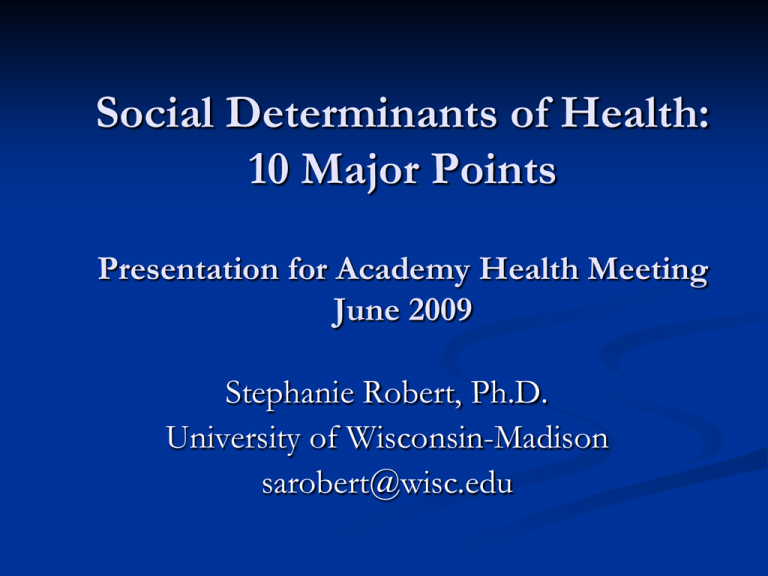
Social Determinants of Health: 10 Major Points Presentation for Academy Health Meeting June 2009 Stephanie Robert, Ph.D. University of Wisconsin-Madison sarobert@wisc.edu What are social determinants of health? “The social determinants of health are the conditions in which people are born, grow, live, work and age, including the health system. These circumstances are shaped by the distribution of money, power and resources at global, national and local levels, which are themselves influenced by policy choices. The social determinants of health are mostly responsible for health inequities - the unfair and avoidable differences in health status seen within and between countries.” - WHO Commission on Social Determinants of Health #1: Health care is only one of many factors that affect health. Health care is only one of many factors that affect health and well-being… Social Environment Individual Response Behavior Biology Physical Environment Health & Function Well-Being Disease Genetic Endowment Health Care Prosperity SOURCE: R.G. Evans & G.L. Stoddart (1990). “Predicting Health, Consuming Health Care,” Social Science & Medicine. From the WHO Commission on Social Determinants of Health #2 Although individual health behaviors matter to health, not everyone has an equal opportunity to make healthy lifestyle choices. four-hour documentary series produced by California Newsreel with Vital Pictures, Inc. Chaired by Alice Rivlin and Mark McClellan 2009 report identified non-medical strategies to improve the health of all Americans “Beyond Health Care: New Directions to a Healthier America”. #3 Socioeconomic status disparities in health are strong and persistent. #3 Socioeconomic status disparities in health are strong and persistent. They exist in all countries, they are wide and persistent over time, and they are widening in the U.S. Reciprocal causality: health SES Income, education, wealth, and occupation each have separate effects on health SES has complex, cumulative effects over the life course e.g., Education has strongest effects on the onset of disease Income has strongest effects on the progression of disease (Herd et al., 2007) #4 The relationship between SES and health is characterized by a gradient relationship, but it is still those at the bottom of the SES scale who suffer disproportionately. UK: Whitehall Study of Civil Servants Relative Risk of Mortality from CD Over 25 Yrs 1.9 1.7 1.8 1.5 1.6 1.3 1.1 1.3 0.9 0.7 1 0.5 Admin Prof/Exec Clerical Other #5 Many psychosocial factors are strongly linked to health, particularly quantity and quality of social support, sense of control, and stress. Highlighted Social Determinants Of Health • Socioeconomic status • Stress • Early life factors • Social exclusion • Workplace factors • Unemployment • Social support • Addiction • Food • Transportation 2003. Edited by Richard Wilkinson and Michael Marmot For the World Health Organization New WHO Report August 2008 Health equity through action on the social determinants of health #6 Neighborhood and other geographic contexts matter to health. Neighborhood context affects health Physical Environment Social Environment Housing conditions, air, water, and land quality, safe recreational space Exposure to crime and violence, social networks and supports, community norms and values Service Environment Health and social services, transportation, grocery stores, job opportunities, quality education #7 Racial/ethnic disparities in health are strong and persistent. They exist both through and independent of SES disparities in health. Infant Death Rates by Mother’s Education, 1995 20.0 Deaths per 1,000 population 18.0 16.0 14.0 12.0 White Black 10.0 8.0 6.0 4.0 2.0 0.0 <High School High School Some College Education College grad. + (Health United States, 1998) #8 Racial disparities in residential segregation and racial discrimination can have effects on access to quality medical care (see Unequal Treatment) and exposure to material and psychosocial conditions that affect health. Examples of racism mechanisms Institutional and individual discrimination affect educational, occupational, and economic attainment Racial residential segregation affects access to resources and exposure to unhealthy residential conditions. Institutional and individual discrimination affect access to health-promoting goods and services Perceived racism is a psychosocial stressor that impacts health. #9 Often interventions can actually worsen racial and socioeconomic inequalities in health, as the most advantaged are more rapidly able to take advantage of knowledge, resources, and technology. Mortality at Titanic by passenger class, women and children 80 Women Mortality (%) 70 Children 60 50 40 30 20 10 0 1st 2nd 3rd . Passenger class From Broom L & Selznick P, 1968 1st/2nd 3rd Landing in the Hudson #10 Social policy is health policy. End
